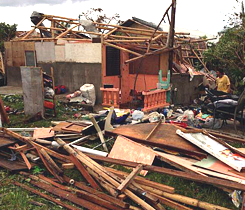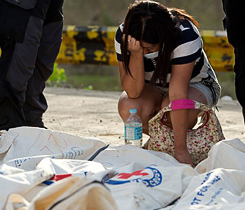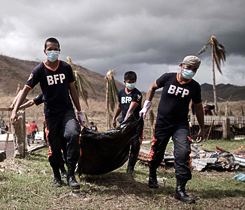
THE RAGING BULLS
This was no hooded thief in the night stealthily breaking into your home in the dark and wee hours of the night unannounced. Rather, this was a stomping herd of over-sized raging and snorting black Spanish bulls which even experienced matadors fear with respect in a corrida de toros, each of them with an intent to cause as much damage and destruction as they collectively could in a mad dash through your door. You can clearly see the horned horde coming as the ground begins to tremble, but there is really no place where you can hide. It’s coming. Typhoon Haiyan rampages into the Philippines!
Nothing like this had been seen before. It was at the top of the destruction scale, perhaps more powerful than Hurricane Katrina – the deadliest and most destructive Atlantic tropical cyclone of the 2005 Atlantic hurricane season, which demolished New Orleans – mercilessly unrelenting and terrifying.
|
Watch The Video
|
|
When Typhoon Haiyan (Yolanda) ripped through the Philippines in the early hours (4.40am) of Friday 8th of November 2013 it was merciless. It was one of the strongest storms ever to make landfall, lashing the area and swallowing coastal towns. Winds up to 315-km/h (195-mph) tore roofs off buildings, turning roads into rivers full of debris and knocking out electricity pylons. The storm surge caused sea waters to rise 20-feet when the typhoon pounced on land. Soon after, many corpses hung on tree branches and buildings. In the aftermath, hundreds of bodies had been found “piled up around the roads” and in churches. Billions of dollars worth of infra structure were damaged or destroyed. Many provinces in the path of the typhoon were left without power or telecommunications, roads and bridges are ruined and airports in the hardest-hit areas, such as Tacloban, in tatters. Relatives of those living in the typhoon’s path have had no news from their loved ones and are nervously waiting until power is restored to the area. Experts say it is impossible to immediately determine the extent of the storm’s damage – or deliver badly needed aid until the passage of several days. |
 |
 |
 |
 |
 |
 |
 |
 |

A TRIPLE WHAMMY HITS
How do you describe a Category-5 storm? The best approach perhaps is to stand it up against a Category-1 storm to highlight the difference. Since Typhoon Haiyan originated in the tropical zone of the Western Pacific Ocean only a few scales of classifications are used by the meteorological agencies monitoring the tropical disturbances and cyclones. These all deal with measuring their maxi mum sustained winds occurring at the ‘eye’ or its centre and the speed of gusts at landfall. However, the definition of ‘sustained winds’ recommended by the World Meteorological organisation (WMO) is generally used by most weather warning centres worldwide based on the Beaufort Scale.
| Category | Meteorological Label | 1-Minute Sustained Winds |
|---|---|---|
| 1 | Tropical Storm | 44- to 62-mph (70- to 100-km/h) |
| 2 | Severe Tropical Storm | 63- to 109-mph (102- to 175-km/h) |
| 3 | Tropical Cyclone | 110- to 129-mph (181- to 207-km/h) |
| 4 | Severe Tropical Typhoon | 130- to 140-mph (209- to 226-km/h) |
| 5 | Super Typhoon | 142- to 148-mph (228- to 239-km/h) |
In the recent history of super-typhoons that have pummelled Philippines Hai yan’s intensity (or ‘Yolanda’, as it was locally known) ranks only 7th among the strongest storms ever to have rampaged through the archipelago – Sening (Joan) in 1970 (171-193/mph); Herming (Betty) in 1987 (162-183/mph); Trining (Ruth) in 1991 (155-177/mph); Anding (Irma) in 1981 (152-171/mph); Saling (Dot) in 1985; Ruping (Mike) in 1990 (149-168/mph) and this year’s Yolanda (Hainan) at 147-171/mph.
Nearly all storms this powerful are actually common in the western Pacific but the deadly typhoon that swept through the Philippines causing severe damage chalked up to a series of bad coincidences.
The Pacific at this time of year is very ripe and juicy for big typhoons. Once or twice a year one gets a Category-5 typhoon out there but it’s a great rarity. Unfortunately, Typhoon Haiyan happened to reach peak intensity just when it was making landfall. And that’s what happened in this case bringing along its wake a triple whammy of surge, very high winds and strong rainfall.
 |
 |
 |
 |
 |
 |
 |
 |
RESISTANCE WAS UTTERLY FUTILE
Even as the Philippine Government, its local city counterparts in all the islands of the Visayas Region and the Philippine Red Cross were making best their prep arations to ‘batten down the hatches’ days before the deadly monster’s landfall, when it finally came knocking resistance was utterly futile. There was simply nothing people in the frontline could do more but implore the Almighty for mercy and safety from the wrath of Nature now descending on them.
Typhoon Haiyan’s path of attack was swift and furious reminiscent of a thun dering invading Mongol Horde making its way through – nearly nothing left standing after its wake. Any piece of land that once bustled with normal daily activities of life and commerce was abruptly wrenched and shattered to pieces. The worst nightmare one could possibly have came through and blasted their senses to numbness and disbelief as the skies darkened with portent and the sound of ferocious winds like banshees warning of death howled through the day.
As communication channels fell silent one by one as hours passed by, the anxiety levels of relatives living in safer areas in the archipelago and those abroad grew with each passing hour and then days, none yet knowing with certainty whether or not their loved ones were still alive. Glued to screens watching international news update footage of the carnage, their anguish almost matched the level of suffering of those who ‘faced the music’ that Typhoon Haiyan had just finished performing for their kin with murderous intent – a sym phony of suffering that would linger for weeks and months on end beyond the yuletide season.
 |
 |
 |
 |
 |
 |
 |
 |
THE REAL SUFFERING BEGINS
Many are now struggling to survive without food, shelter or clean drinking water and a clearer picture is slowly emerging of the full damage wrought by the storm. Here are a few reports that have come in.
According to UN initial figures some 660,000 people have been displaced among a total of 9.8-million affected. As it gets more and more access the UN adds that it is finding the tragedy of more and more people killed in this typhoon. “We have all seen the heartbreaking images of the impact of this huge storm,” a UN Relief official on the ground has said.
Clearly, this is one of the most powerful storms on record to make landfall as it struck the coastal provinces of Leyte and Samar. It then headed west, sweeping through six central Philippine islands (see map below).

The Philippine government has estimated that the super typhoon caused some US$ 559-million in damage given initial assessment reports, nearly evenly split between infrastructure and agriculture. The cost of rebuilding houses, schools, roads and bridges in Typhoon Haiyan-devastated central Philippines could, how ever, reach US$ 6- to 7-billion, or some 2.3 percent of GDP.
Many of the survivors left affected provinces out of desperation without any plan or means of livelihood. The growing exodus is an extra challenge to President Aquino’s government, which is feeding and sheltering tens of thousands of people in the disaster zones, collecting the dead in all damaged provincial cities and outlying towns, restoring power, communications and water and laying out a blueprint to rebuild what has been demolished by Haiyan. More than a million houses were destroyed or damaged during the super-storm.
 |
 |
 |
 |
 |
 |
 |
 |
HOW TO REACH THEM
Recounting the experience of Haiti following the 2010 earthquake as a cautionary tale that spread virally within the Philippines and among overseas Filipinos, it’s not surprising that Philippine Diaspora communities across the globe (now numbering some 12-million individuals) and other foreign aid donors as well are concerned about corruption when it comes to relief, recovery and restoration efforts.
In the past, the Philippines performed badly in worldwide measures of corrup tion. However, before the typhoon struck, the country had been making substantial progress in fighting corruption and improving the management of public finances under the leadership of its President, Benigno ‘Noynoy’ Aquino III.
Provided herein below are a few infographics detailing some useful information which private donors might want to check out before deciding to act on their own giving.

Foreign assistance is vital in confronting the threats of severe malnutrition and disease outbreaks that follow a disastrous natural event particularly if the scale of devastation and dislocation of people victimised is such as one as what Typhoon Haiyan wrought on the central parts of Philippines. Preliminary damage and relief assessments need to be done quickly but thoroughly before the real relief and restoration work can begin to trickle in.
While some official foreign aid and smaller private sector donations are just beginning to flow into the Philippines, transparency is essential for the account ability for aid funds and donations that are and will continue to come in from both foreign and local sources.

But as the influx of aid funding and relief goods grows to match the scale of needs it raises fears of another real threat – that corruption from a few regional and petty local officials will prevent aid money from actually benefitting the people who need it the most.

The Philippine government’s online Foreign Aid Transparency Hub, FAiTH, re ports that international donors have pledged more than US$ 290-million to help with relief and recovery. It demonstrates that the government of this country understands that transparency and proper accounting is an effective weapon against the threat of corruption, and is committed to accountability for aid funds.
But, the Philippine government needs all parties providing aid and relief to be strong partners in the drive for accountability and recovery. Such partners themselves should also ensure that their own giving and spending to support typhoon recovery efforts is also fully transparent and channelled in to the Phil ippines through reliable agencies and non-government organisations with exemplary reputations they trust.

Filipinos in Hamilton | Still There is Hope
______________________________________________________________

 During the Spanish
During the Spanish





























